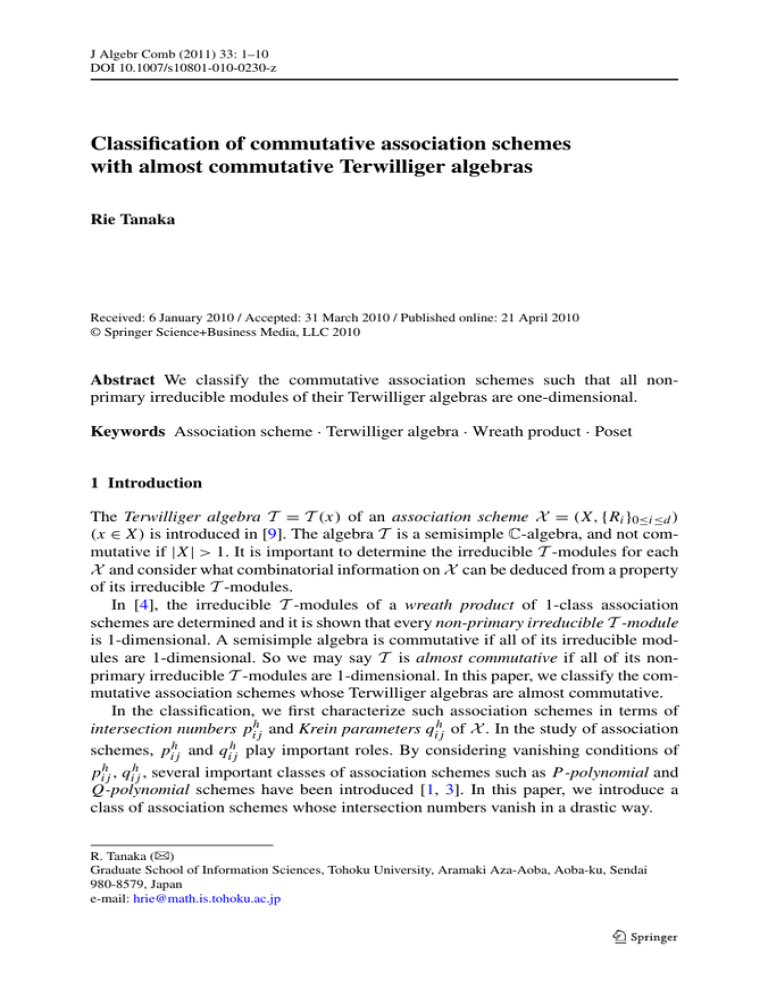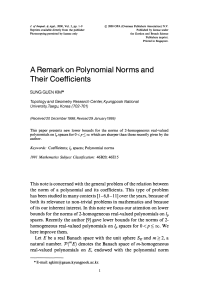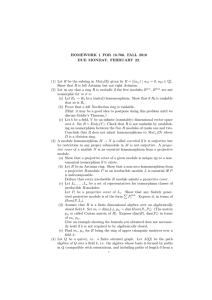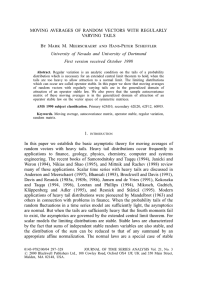Classification of commutative association schemes with almost commutative Terwilliger algebras Rie Tanaka
advertisement

J Algebr Comb (2011) 33: 1–10
DOI 10.1007/s10801-010-0230-z
Classification of commutative association schemes
with almost commutative Terwilliger algebras
Rie Tanaka
Received: 6 January 2010 / Accepted: 31 March 2010 / Published online: 21 April 2010
© Springer Science+Business Media, LLC 2010
Abstract We classify the commutative association schemes such that all nonprimary irreducible modules of their Terwilliger algebras are one-dimensional.
Keywords Association scheme · Terwilliger algebra · Wreath product · Poset
1 Introduction
The Terwilliger algebra T = T (x) of an association scheme X = (X, {Ri }0≤i≤d )
(x ∈ X) is introduced in [9]. The algebra T is a semisimple C-algebra, and not commutative if |X| > 1. It is important to determine the irreducible T -modules for each
X and consider what combinatorial information on X can be deduced from a property
of its irreducible T -modules.
In [4], the irreducible T -modules of a wreath product of 1-class association
schemes are determined and it is shown that every non-primary irreducible T -module
is 1-dimensional. A semisimple algebra is commutative if all of its irreducible modules are 1-dimensional. So we may say T is almost commutative if all of its nonprimary irreducible T -modules are 1-dimensional. In this paper, we classify the commutative association schemes whose Terwilliger algebras are almost commutative.
In the classification, we first characterize such association schemes in terms of
h and Krein parameters q h of X . In the study of association
intersection numbers pij
ij
h and q h play important roles. By considering vanishing conditions of
schemes, pij
ij
h , q h , several important classes of association schemes such as P -polynomial and
pij
ij
Q-polynomial schemes have been introduced [1, 3]. In this paper, we introduce a
class of association schemes whose intersection numbers vanish in a drastic way.
R. Tanaka ()
Graduate School of Information Sciences, Tohoku University, Aramaki Aza-Aoba, Aoba-ku, Sendai
980-8579, Japan
e-mail: hrie@math.is.tohoku.ac.jp
2
J Algebr Comb (2011) 33: 1–10
h = 0 (0 ≤ h, i, j ≤ d).
(B) For all distinct h, i, there is exactly one j such that pij
(B∗ ) For all distinct h, i, there is exactly one j such that qijh = 0 (0 ≤ h, i, j ≤ d).
The following is the main theorem of this paper:
Theorem 1 Let X = (X, {Ri }0≤i≤d ) be a commutative association scheme. The following are equivalent:
(i)
(ii)
(iii)
(iv)
(v)
Every non-primary irreducible T (x)-module is 1-dimensional for some x ∈ X.
Every non-primary irreducible T (x)-module is 1-dimensional for all x ∈ X.
The intersection numbers of X satisfy (B).
The Krein parameters of X satisfy (B∗ ).
X is a wreath product of association schemes X1 , X2 , . . . , Xn where each Xi
is either a 1-class association scheme or the group scheme of a finite abelian
group.
Moreover, if (i)–(v) hold, X is triply regular.
The paper is organized as follows: Sect. 2 reviews some basic properties of association schemes and their Terwilliger algebras. In the proof of Theorem 1, we will
adopt the following strategy. In Sect. 3, we will prove the equivalence of assertions
(i)–(iv) from the theorem. In Sect. 4, we will prove the equivalence of assertions (iii)
and (v) from the theorem.
2 Preliminaries
For general introduction to association schemes and Terwilliger algebras, we refer
the reader to [1, 3, 6, 9].
Let X be a finite nonempty set and MatX (C) the set of square complex matrices
whose entries are indexed by the elements of X. Let R0 , R1 , . . . , Rd be nonempty
subsets of X × X, and for each 0 ≤ i ≤ d, let Ai ∈ MatX (C) be the adjacency matrix
of Ri :
1 if (x, y) ∈ Ri ,
(Ai )xy =
0 otherwise.
The pair X = (X, {Ri }0≤i≤d ) is called a d-class association scheme if the following
(AS1)–(AS4) hold:
(AS1)
(AS2)
(AS3)
(AS4)
A0 = I , the identity matrix.
A0 + A1 + · · · + Ad = J , the all-one’s matrix.
For 0 ≤ i ≤ d, there is 0 ≤ i ≤ d such that Ai = ATi , the transpose of Ai .
Ai Aj is a linear combination of A0 , A1 , . . . , Ad for 0 ≤ i, j ≤ d.
By (AS1) and (AS4), M := Span{A0 , A1 , . . . , Ad } is a subalgebra of MatX (C);
this is the Bose–Mesner algebra of X . By (AS2), the Ai are linearly independent and
thus form a basis for M. We say X is commutative if M is commutative.
J Algebr Comb (2011) 33: 1–10
3
Throughout the paper, we assume X is commutative. By (AS3), M is closed under
conjugate-transposition. Hence M is a commutative semisimple algebra and has a
basis {Ei : 0 ≤ i ≤ d} of primitive idempotents:
Ei Ej = δij Ei ;
(1)
E0 + E1 + · · · + Ed = I ;
(2)
where we always set E0 = |X|−1 J. Note that for each 0 ≤ i ≤ d, there is 0 ≤ î ≤ d
such that Eî = EiT . It also follows from (AS2) that M is closed under entry-wise
multiplication denoted ◦.
h and the Krein parameters q h are defined by the
The intersection numbers pij
ij
following equations:
Ai Aj =
d
Ei ◦ Ej = |X|−1
h
pij
Ah ,
h=0
d
qijh Eh
(0 ≤ i, j ≤ d).
(3)
h=0
h = |R (x) ∩
Let Ri (x) := {y ∈ X : (x, y) ∈ Ri } (x ∈ X, 0 ≤ i ≤ d). By (3), pij
i
h
Rj (y)| where (x, y) ∈ Rh (x, y ∈ X). Clearly, the pij are non-negative integers. In
particular, ki := pii0 = |Ri (x)| = 0. We can also verify that the qijh are non-negative
real numbers and mi := q 0 = tr Ei = 0 [1, 6]. Note that
i î
ki =
d
j
pih
(0 ≤ i, j ≤ d);
(4)
h=0
h
=0
pij
⇐⇒
i
phj
=0
⇐⇒
j
pi h = 0;
h
pij
= pjhi .
(5)
(6)
Fix x ∈ X. For each 0 ≤ i ≤ d, let Ei∗ = Ei∗ (x), A∗i = A∗i (x) be the diagonal
matrices in MatX (C) with yy-entries (Ei∗ )yy = (Ai )xy , (A∗i )yy = |X|(Ei )xy . By definition, we have the following:
Ei∗ Ej∗ = δij Ei∗
(0 ≤ i, j ≤ d);
E0∗ + E1∗ + · · · + Ed∗ = I.
(7)
(8)
We also have the following:
A∗0 = I ;
(9)
A∗0 + A∗1 + · · · + A∗d = |X|E0∗ ;
A∗i A∗j =
d
qijh A∗h
(10)
(0 ≤ i, j ≤ d).
(11)
h=0
The Ei∗ and the A∗i form two bases for the dual Bose–Mesner algebra M∗ =
M∗ (x) with respect to x. The Terwilliger algebra T = T (x) of X with respect to
4
J Algebr Comb (2011) 33: 1–10
x is the subalgebra of MatX (C) generated by M and M∗ . Since T is closed under
conjugate-transposition, it is semisimple. It is easily shown that T is not commutative
if |X| > 1. We can verify the following:
Lemma 2 ([9])
h = 0.
(i) Ei∗ Aj Eh∗ = 0 if and only if pij
(ii) Ei A∗j Eh = 0 if and only if qijh = 0.
Nonzero matrices among Ei∗ Aj Eh∗ (0 ≤ h, i, j ≤ d) form a basis of M∗ MM∗ ,
and T is generated by M∗ MM∗ . When T coincides with M∗ MM∗ , X has a
special regularity:
Definition 3 X is called triply regular if for all 0 ≤ h, i, j, l, m, n ≤ d, the size
Rh (x) ∩ Ri (y) ∩ Rj (z)
is independent of x, y, z ∈ X where (x, y) ∈ Rl , (y, z) ∈ Rm , (x, z) ∈ Rn .
Proposition 4 ([7]) X is triply regular if and only if T (x) = M∗ (x)MM∗ (x) for
all x ∈ X.
The triple-regularity was first introduced in the study of spin models (see [5]).
Let CX be the set of the complex column vectors with coordinates indexed by X,
and observe that MatX (C) acts on CX from the left. We equip CX with the Hermitian
inner product , . For y ∈ X, let ŷ be the vector in CX with a 1 in coordinate y and
0 elsewhere. Then {ŷ : y ∈ X} forms an orthonormal basis of CX .
For a T -module W , its orthogonal complement W ⊥ is also a T -module since T
is closed under conjugate-transposition.
Thus CX is decomposed as a direct sum of
irreducible T -modules. Let 1 := y∈X ŷ ∈ CX .
Lemma 5 ([9]) The space Span{Ei∗ 1 : 0 ≤ i ≤ d} = Span{Ei x̂ : 0 ≤ i ≤ d} is an
irreducible T (x)-module of dimension d + 1.
The T -module in Lemma 5 will be denoted W0 = W0 (x). This T -module W0 is
said to be primary.
(1)
(2)
Definition 6 Let X1 = (X1 , {Ri }0≤i≤d1 ), X2 = (X2 , {Ri }0≤i≤d2 ) be association
(1)
(2)
schemes, and Ai (0 ≤ i ≤ d1 ), Ai (0 ≤ i ≤ d2 ) their adjacency matrices. Let X =
X1 × X2 and Ri (0 ≤ i ≤ d1 + d2 ) be subsets of X × X whose adjacency matrices Ai
are defined as follows:
(1)
(2)
Ai = Ai ⊗ A0
(2)
Ad1 +i = J ⊗ Ai
(0 ≤ i ≤ d1 ),
(1 ≤ i ≤ d2 ),
where ⊗ denotes the Kronecker product. Then (X, {Ri }0≤i≤d1 +d2 ) is an association
scheme; this is called the wreath product of X1 and X2 , denoted X1 X2 .
J Algebr Comb (2011) 33: 1–10
5
Definition 7 Let P, Q be partially ordered sets (posets). The ordinal sum P ⊕ Q of
P and Q is the poset on the union P ∪ Q such that x ≺ y in P ⊕ Q if (a) x ≺ y in P,
or (b) x ≺ y in Q, or (c) x ∈ P and y ∈ Q.
Basic concepts and properties of posets can be found in [8, Chap. 3].
3 Characterization
In this section, we prove the equivalence of (i)–(iv) in Theorem 1. Fix x ∈ X. Let
T = T (x) be the Terwilliger algebra of X with respect to x.
Lemma 8 The following are equivalent:
(i)
(ii)
(iii)
(iv)
CX = W 0 .
ki = 1 for all 0 ≤ i ≤ d.
mi = 1 for all 0 ≤ i ≤ d.
X is the group association scheme of a finite abelian group.
Moreover, if (i)–(iv) hold, then (B) and (B∗ ) hold.
Proof Since 1 = dimEi∗ W0 ≤ dimEi∗ CX = ki , we have (i) ⇔ (ii). Similarly, we have
(i) ⇔ (iii). Obviously, M is a group algebra if and only if (ii) holds. Since X is
commutative, we have (ii) ⇔ (iv). The last assertion is clear.
See [1, 2], for details of group association schemes.
Lemma 9 The following hold.
(i) (B) holds if and only if Ei∗ Aj Eh∗ = |X|Ei∗ E0 Eh∗ for 0 ≤ h, i, j ≤ d with h = i
h = 0.
and pij
∗
(ii) (B ) holds if and only if Ei A∗j Eh = |X|Ei E0∗ Eh for 0 ≤ h, i, j ≤ d with h = i
and qijh = 0.
Proof (i) Note that by (AS2), |X|Ei∗ E0 Eh∗ = Ei∗ Aj Eh∗ + l=j Ei∗ Al Eh∗ . Suppose
h = 0 and h = i. By Lemma 2 and (B), E ∗ A E ∗ = 0 only if l = j .
(B) holds. Let pij
i l h
∗
∗ = E ∗ A E ∗ . Conversely, suppose E ∗ A E ∗ = |X|E ∗ E E ∗ . Then
E
E
Thus |X|E
0
j
j
h
i
h
i
h
i 0 h
i
we have l=j Ei∗ Al Eh∗ = 0. Since the Ei∗ Al Eh∗ are linearly independent, Ei∗ Al Eh∗ =
0 if l = j, that is, pilh = 0 only if l = j. We obtain (B). (ii) By exchanging the roles
h , E ∗ , A , (AS2) by those of the q h , E , A∗ , (10), we obtain the assertion. of the pij
i
i
ij
i
i
Proposition 10 If every non-primary irreducible T -module is 1-dimensional, then
(B), (B∗ ) hold.
Proof By Lemma 8, if CX = W0 , (B), (B∗ ) hold. Suppose CX = W0 . Since the
nontrivial subspaces Eh∗ W0⊥ are direct sums of non-primary irreducible T -modules,
h = 0 and h = i. Let
they are T -modules. Hence Ei∗ Aj Eh∗ W0⊥ = 0 if h = i. Let pij
6
J Algebr Comb (2011) 33: 1–10
u2 , . . . , ukh be a basis of Eh∗ W0⊥ . Then Eh∗ 1, u2 , . . . , ukh form a basis of Eh∗ CX .
h E ∗ 1 and |X|E ∗ E E ∗ 1 = k E ∗ 1. Clearly, E ∗ A E ∗ u =
We have Ei∗ Aj Eh∗ 1 = pij
h i
i
i 0 h
i j h l
h · |X|E ∗ E E ∗ . Since
∗
∗
|X|Ei E0 Eh ul = 0 (2 ≤ l ≤ kh ). Hence kh · Ei∗ Aj Eh∗ = pij
i 0 h
h
|X|Ei∗ E0 Eh∗ = dl=0 Ei∗ Al Eh∗ and the Ei∗ Al Eh∗ are linearly independent, kh = pij
∗
∗
∗
∗
and thus Ei Aj Eh = |X|Ei E0 Eh . By Lemma 9, (B) holds. Similarly, exchanging the
h , E ∗ , A , 1 by those of the q h , E , A∗ , x̂, (B∗ ) holds.
roles of pij
i
i
ij
i
i
Lemma 11 The following hold.
(i) If (B) holds, then Ei∗ MEi∗ is a commutative algebra for 0 ≤ i ≤ d.
(ii) If (B∗ ) holds, then Ei M∗ Ei is a commutative algebra for 0 ≤ i ≤ d.
Proof (i) By (7), (8) and Lemma 9, for h, j (0 ≤ h, j ≤ d) we have
Ei∗ Ah Aj Ei∗
= Ei∗ Ah
d
El∗
Aj Ei∗ = Ei∗ Ah Ei∗ Aj Ei∗ +
l=0
= Ei∗ Ah Ei∗ · Ei∗ Aj Ei∗ +
Ei∗ Ah El∗ Aj Ei∗
l=i
Ei∗ Ah El∗ · El∗ Aj Ei∗
l=i
= Ei∗ Ah Ei∗ · Ei∗ Aj Ei∗ +
|X|2 Ei∗ E0 El∗ E0 Ei∗
l =0,p i =0
l=i,pih
lj
= Ei∗ Ah Ei∗ · Ei∗ Aj Ei∗ +
kl |X|Ei∗ E0 Ei∗ .
l =0,p i =0
l=i,pih
lj
Therefore
Ei∗ Ah Ei∗ · Ei∗ Aj Ei∗ = Ei∗ Ah Aj Ei∗ −
kl |X|Ei∗ E0 Ei∗
l =0,p i =0
l=i,pih
lj
=
d
l
phj
Ei∗ Al Ei∗ −
l=0
kl |X|Ei∗ E0 Ei∗ .
(12)
l =0,p i =0
l=i,pih
lj
Hence Ei∗ MEi∗ is closed under multiplication. Since M is commutative, by (12),
h , E ∗ , A , M,
is commutative as well. (ii) Exchanging the roles of the pij
i
i
h
∗
∗
(7), (8) by those of the qij , Ei , Aj , M , (1), (2), the assertion holds.
Ei∗ MEi∗
Lemma 12 The following hold.
(i) If (B) holds, then T = M∗ MM∗ .
(ii) If (B∗ ) holds, then T = MM∗ M.
Proof (i) Let U := Span{Ei∗ E0 Eh∗ : h = i, 0 ≤ h, i ≤ d}. By Lemma 9, U =
Span{Ei∗ Aj Eh∗ : h = i, 0 ≤ h, i, j ≤ d}. Hence M∗ MM∗ = ( di=0 Ei∗ MEi∗ ) ⊕ U
J Algebr Comb (2011) 33: 1–10
7
(a direct sum). By Lemma 11 and calculations in its proof, the Ei∗ MEi∗ and U are
closed under multiplication. We can easily verify that the Ei∗ MEi∗ act on U from
both the left and the right. Thus M∗ MM∗ forms an algebra, i.e., T = M∗ MM∗ .
h , E ∗ , A , M by those of the q h , E , A∗ , M∗ , the
(ii) Exchanging the roles of the pij
i
i
ij
i
i
assertion holds.
Corollary 13 If (B) holds, X is triply regular.
Proof By Proposition 4 and Lemma 12, the assertion holds.
Proposition 14 The following hold.
(i) If (B) holds, every non-primary irreducible T -module is 1-dimensional.
(ii) If (B∗ ) holds, every non-primary irreducible T -module is 1-dimensional.
Proof (i) By Lemma 11, Ei∗ MEi∗ is a commutative semisimple algebra. Hence
Ei∗ CX is decomposed as the direct sum of the common eigenspaces of Ei∗ MEi∗ .
Assume CX = W0 . Let u ∈ (Ei∗ CX ) ∩ W0⊥ be a common eigenvector of Ei∗ MEi∗ .
Since Span{u} is closed under the action of M∗ MM∗ , by Lemma 12, it is a T module. In this way, (Ei∗ CX ) ∩ W0⊥ is decomposed as a direct sum of 1-dimensional
irreducible T -modules. The assertion is clear. (ii) Exchanging the roles of the Ei∗ , M
by those of the Ei , M∗ , the assertion holds.
Proof of Theorem 1 (i) ⇔ (ii) ⇔ (iii) ⇔ (iv) By Proposition 10, we have (i) ⇒ (iii)
and (i) ⇒ (iv). By Proposition 14, we have (iii) ⇒ (ii) and (iv) ⇒ (ii). Obviously, (ii)
⇒ (i).
4 Classification
In this section, we prove (iii) ⇔ (v) in Theorem 1. Throughout the section, let X =
(X, {Ri }0≤i≤d ) be a commutative association scheme whose intersection numbers
satisfy (B).
j
j
j
j
Lemma 15 If pij = 0 for 1 ≤ i, j ≤ d, then pi j = 0, pij = 0 and pi j = 0.
j
j
i = 0. Again by (5), p
Proof By (5), pi j = 0 and pjj
j i = 0, and by (6) we have
j
j
pij = 0. Again by (5), pi j = 0.
Lemma 16 If pi j = 0 for 1 ≤ i, j ≤ d with i = j , then Ai Aj = pij Aj .
j
j
j
j
l = 0. Hence p l = 0
Proof By (B), pi l = 0 if l = j. By (5), pi l = 0 if and only if pij
ij
if l = j, and the assertion holds.
Let [i] = [i ] := {i, i } for 1 ≤ i ≤ d.
8
J Algebr Comb (2011) 33: 1–10
Lemma 17 Let ≺ be the relation on {[i] : 1 ≤ i ≤ d} defined as follows: [i] ≺ [j ] if
j
[i] = [j ] or pij = 0. Then ≺ is a partial order.
Proof By Lemma 15, the relation ≺ is well-defined. By definition, ≺ is reflexive.
j
Suppose [i] ≺ [j ] and [j ] ≺ [i]. Moreover suppose pij =
0 and pji i = 0. Since
i = 0. If i = j, by (B), p i = 0 only if l = j . Since p i = 0,
pij = 0, by (5), pjj
jl
ji
i = j . Thus [i] = [j ] and ≺ is antisymmetric. Suppose [h] ≺ [i] and [i] ≺ [j ] for
j
distinct [h], [i], [j ]. Since phi i = 0, pi j = 0 and h = i, i = j, by Lemma 16,
j
j
j
i A A = p i p A = 0. On the other hand, A (A A ) = p A A .
(Ah Ai )Aj = phi
i j
h
i j
ij h j
hi ij j
j
j
Therefore Ah Aj = phj Aj = 0 and phj = 0. Hence [h] ≺ [j ], and thus ≺ is transitive.
For the rest of the section, let P := ({[i] : 1 ≤ i ≤ d}, ≺) be the poset defined in
Lemma 17.
Lemma 18 Let [i] be a minimal element of P. If ki ≥ 2, then [i] is the minimum.
Proof Suppose ki ≥ 2. Let x ∈ X. Take distinct y, z ∈ Ri (x). Since [i] is minimal,
(y, z) ∈ Ri ∪ Ri . Let [j ] ∈ P \ {[i]} and w ∈ Rj (x). Since i = j , by (B), y, z ∈
h = p h = 0, and [i] ≺ [h]. If [h] = [i], by the
Rh (w) for some 1 ≤ h ≤ d. Hence phi
ih
configuration of x, y, w, we have pji i = 0 or pji i = 0, i.e., [j ] ≺ [i], contradicting [i]
i = 0. Since
is minimal. Hence [h] = [i]. By the configuration of x, w, y, pji h = phj
i = 0, h = j. So [h] = [j ]. Since [i] ≺ [h], we have [i] ≺ [j ].
[h] = [i] and phh
Lemma 19 The following hold.
(i) If P is a singleton, then either d = 1 or X is the group association scheme of Z3 .
(ii) If P is an antichain with at least 2 elements, X is the group association scheme
of a finite abelian group.
Proof (i) Let P = {[i]}. Suppose ki ≥ 2. Then piii = 0. By (5), (6), we have pii i =
i +p i ≤ d p i =
piii = 0. If i = i , by (B), (4), ki = dl=0 pii l = pii i = piii < pi0
l=0 il
ii ki , contradicting ki = ki . Hence i = i , i.e., d = 1. Suppose d = 1. Then ki = ki = 1
and by Lemma 8, X is the group association scheme of Z3 . (ii) By Lemma 18, ki = 1
for all [i] ∈ P. By Lemma 8, the assertion holds.
Lemma
20 Suppose P = P1 ⊕ P2 for some subposets P1 , P2 of P. Then R0 ∪
( [i]∈P1 Ri ) is an equivalence relation on X, i.e., X is imprimitive. Moreover, Ai
(1 ≤ i ≤ d) can be written as follows:
Ai = Bi ⊗ Iq
Ai = Jp ⊗ Ci
[i] ∈ P1 ;
[i] ∈ P2 ;
J Algebr Comb (2011) 33: 1–10
9
where B0 = Ip , Bi ([i] ∈ P1 ) are the adjacency matrices of the subscheme X1 and
C0 = Iq , Ci ([i] ∈ P2 ) are those of the quotient scheme X2 = X /X1 . In particular,
X = X1 X2 .
Proof The first assertion is clear. By [1, Theorem II.9.3], the equations on Ai
([i] ∈ P1 ) hold. Let ∼ be the relation on {0, 1, . . . , d} defined as i ∼ j if pji α = 0
for some α ∈ [α] ∈ P1 . Then ∼ is an equivalence relation. Clearly, {0} ∪ {i : [i] ∈ P1 }
i = 0 for all α ∈ [α] ∈ P . Since i = α, by
is an equivalence class. For [i] ∈ P2 , pαi
1
i = 0 if j = i. In particular, for [j ] ∈ P , p i = p i = 0 if j = i. Hence each
(B), pαj
2
jα
αj
i ([i] ∈ P2 ) forms an equivalence class. By [1, Theorem II.9.4], the equations on Ai
([i] ∈ P2 ) hold. The last assertion is clear by Definition 6.
Corollary 21 We keep the notation of Lemma 20. Both X1 and X2 are commutative
association schemes whose intersection numbers satisfy (B) and whose corresponding posets are P1 and P2 respectively.
For details of imprimitive association schemes, see [1, Sect. II.9].
Lemma 22 Suppose [i], [j ] ∈ P are incomparable. If [i] ≺ [h] for some [h] ∈ P \
{[i], [j ]}, then [j ] ≺ [h].
Proof Let x ∈ X. Take y ∈ Ri (x), z ∈ Rj (x) and w ∈ Rh (x). Since [i] ≺ [h], i.e.,
h = 0, by (B), p h = 0 if l = h. So (y, w) ∈ R . Let (y, z) ∈ R and (z, w) ∈ R .
pih
h
s
t
il
h = 0 and
By the configurations of 3 vertices x, z, w and y, z, w, we obtain pjht = ptj
h = p h = 0. If t = h, by (B), we have s = j and by the configuration of x, y, z,
pst
ts
j
we have pij = 0 contradicting the assumption that [i], [j ] are incomparable. Hence
t = h and pjhh = 0, i.e., [j ] ≺ [h].
Proposition 23 P is an ordinal sum of singletons and antichains.
Proof Let P1 be the set of minimal elements of P. Clearly, P1 is either a singleton
or an antichain. By Lemma 22, P = P1 ⊕ (P \ P1 ). Next let P2 be the set of minimal
elements of P \ P1 . Similarly we obtain P \ P1 = P2 ⊕ (P \ (P1 ⊕ P2 )). Repeating
this process, we finally obtain P = P1 ⊕ P2 ⊕ · · · ⊕ Pm , where Pi (1 ≤ i ≤ m) is
either a singleton or an antichain.
Proof of Theorem 1 (iii) ⇔ (v) By Proposition 23, P = P1 ⊕ P2 ⊕ · · · ⊕ Pm , where
Pl (1 ≤ l ≤ m) is a singleton or an antichain. By Lemma 20, the subposet P1 induces
the subscheme X1 of X , and X = X1 Y1 where Y1 denotes the quotient scheme
X /X1 . By Corollary 21, Y1 satisfies (B) and corresponds to the poset P2 ⊕ · · · ⊕ Pm .
Again, the subposet P2 induces the subscheme X2 of Y1 , and Y1 = X2 Y2 where Y2
denotes the quotient scheme Y1 /X2 . Repeating this process, we finally obtain X =
X1 X2 · · · Xm , where Xl (1 ≤ l ≤ m) corresponds to the poset Pl . By Lemma 19,
Xl is a 1-class association scheme or the group association scheme of a finite abelian
group. This completes the proof.
10
J Algebr Comb (2011) 33: 1–10
Remark Let X be a symmetric association scheme. Then X is a wreath product of
1-class association schemes if and only if P is a chain.
Acknowledgements The author would like to thank Hajime Tanaka for valuable discussions and suggestions. She would also like to thank Paul Terwilliger for his careful reading of the manuscript.
References
1. Bannai, E., Ito, T.: Algebraic Combinatorics I. Benjamin/Cummings, Redwood City (1984)
2. Bannai, E., Munemasa, A.: The Terwilliger algebras of group association schemes. Kyushu J. Math.
49, 93–102 (1995)
3. Brouwer, A.E., Cohen, A.M., Neumaier, A.: Distance-Regular Graphs. Springer, Berlin, Heidelberg
(1989)
4. Bhattacharyya, G., Song, S.-Y., Tanaka, R.: On Terwilliger algebras of wreath products of one-class
association schemes. J. Algebr. Comb. 31, 455–466 (2010)
5. Jaeger, F.: On spin models, triply regular association schemes, and duality. J. Algebr. Comb. 4, 103–144
(1995)
6. Martin, W.J., Tanaka, H.: Commutative association schemes. Eur. J. Comb. 30, 1497–1525 (2009)
7. Munemasa, A.: An application of Terwilliger algebra. Unpublished preprint. Preprint found on:
http://www.math.is.tohoku.ac.jp/~munemasa/unpublished.html
8. Stanley, R.P.: Enumerative Combinatorics, vol. I. Cambridge Univ. Press, Cambridge (2002)
9. Terwilliger, P.: The subconstituent algebra of an association scheme (Part I). J. Algebr. Comb. 1, 363–
388 (1992). (Part II; III), J. Algebr. Comb. 2, 73–103; 177–210 (1993)








